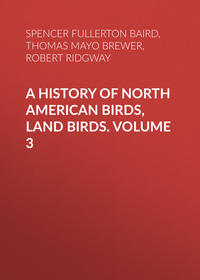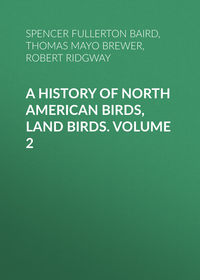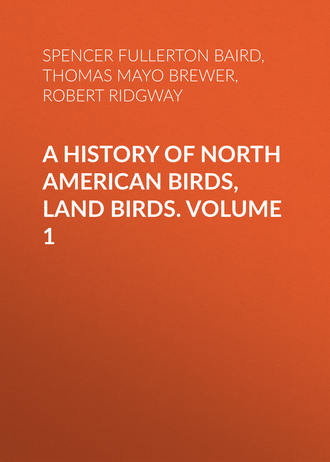 полная версия
полная версияA History of North American Birds, Land Birds. Volume 1
Mr. William F. Hall met with the nest and eggs of this bird at Camp Sebois in the central eastern portion of Maine. It was built in an unoccupied log-hut, among the fir-leaves and mosses in a crevice between the logs. It was large and bulky, composed externally of mosses and lined with the fur of hedge-hogs, and the feathers of the spruce partridge and other birds. It was in the shape of a pouch, and the entrance was neatly framed with fine pine sticks. The eggs were six in number, and somewhat resembled those of the Parus atricapillus. The female was seen and fully identified.
In this nest, which measured five and three quarters inches by five in breadth, the size, solidity, and strength, in view of the diminutive proportions of its tiny architect, are quite remarkable. The walls were two inches in thickness and very strongly impacted and interwoven. The cavity was an inch and a quarter wide and four inches deep. Its hemlock framework had been made of green materials, and their strong and agreeable odor pervaded the structure. The eggs measured .65 by .48 of an inch, and were spotted with a bright reddish-brown and a few pale markings of purplish-slate, on a pure white ground. Compared with the eggs of the European Wren their eggs are larger, less oval in shape, and the spots much more marked in their character and distinctness.
Troglodytes parvulus, var. alascensis, BairdALASKA WRENTroglodytes alascensis, Baird, Trans. Chicago Acad. Sc. I, ii, 315, pl. xxx, fig. 3, 1869.—Dall & Bannister (Alaska).—Finsch, Ornith. N. W. Amerikas, 1872, 30.
Sp. Char. ♂ ad., 61,329, Amaknak Island, Unalaschka, Oct. 21, 1871; W. H. Dall. Above umber-brown, more rufescent on the wings, rump, and tail; secondaries and tail-feathers showing indistinct transverse dusky bars; primaries about equally barred with blackish and dilute umber or brownish-white; middle-coverts tipped with a small white dot, preceded by a black one. Lower part, including a rather distinct superciliary stripe, pale ochraceous-umber; sides, flanks, abdomen, and crissum distinctly barred with dusky and whitish on a rusty ground; crissum with sagittate spots of white. Wing, 2.20; tail, 1.60; culmen, .65; tarsus, .75.
Hab. Aleutian and Pribylow Islands, Alaska.
The specimen above described represents about the average of a large series obtained on Amaknak Island by Mr. Dall. They vary somewhat among themselves as regards dimensions, but all are very much larger than any specimens of T. hyemalis, from which it also differs in longer, straighter, and more subulate bill (the gonys slightly ascending). The type specimen from St. George’s Island was immature, and we embrace the opportunity of giving the description of an adult sent down with several others in the autumn of 1871 by Mr. Dall from Unalaschka.
This form bears the same relation to T. hyemalis that Melospiza unalaschkensis does to M. melodia; T. pacificus, like M. rufina, being an intermediate form.
Habits. Of this new variety, the Alaska Wren, but little is as yet known as to its personal history. Mr. Dall states that it is found in abundance all the year round on St. George’s Island, and that it breeds in May, building a nest of moss in the crevices of the rocks, and, according to the Aleuts, lays six eggs. Mr. Dall subsequently found it quite common at Unalaschka in the summer of 1871.
Genus CISTOTHORUS, CabanCistothorus, Cabanis, Mus. Hein. 1850, 1851, 77. (Type, Troglodytes stellaris.)
Telmatodytes, Cabanis, Mus. Hein. 1850, 1851, 78. (Type, Certhia palustris.)
Thryothorus, Vieillot, Analyse, 1816, according to G. R. Gray.

Cistothorus palustris.
1454 ♂
Gen. Char. Bill about as long as the head or much shorter, much compressed, not notched, gently decurved from the middle; the gonys slightly concave or straight. Toes reaching to the end of the tail. Tarsus longer than the middle toe. Hind toe longer than the lateral, shorter than the middle. Lateral toes about equal. Hind toe longer than or equal to its digit. Wings rather longer than the tail, all the feathers of which are much graduated; the lateral only two thirds the middle. The feathers narrow. Back black, conspicuously streaked with white.
Of this genus there are two sections, Cistothorus proper and Telmatodytes, the diagnoses of which have already been given. The two North American species present the feature, unique among our Wrens, of white streaks on the back.
A. Cistothorus. Bill half length of head. No white superciliary streak. Head and rump and back streaked with white. Tail dusky, barred with brown … C. stellaris.
B. Telmatodytes. Bill length of head. A white superciliary stripe. Back alone streaked with white. Tail-feathers black, barred with whitish … C. palustris.
Cistothorus stellaris, CabanSHORT-BILLED MARSH-WRENTroglodytes stellaris, “Licht.” Naumann, Vögel Deutschlands, III, 1823, 724 (Carolina). Cistothorus stellaris, Cab. Mus. Hein. 77.—Baird, Birds N. Am. 1858, 365; Rev. 146.—Sclater, Catal. 22, No. 142.(in part). Troglodytes brevirostris, Nutt. Man. I, 1832, 436.—Aud. Orn. Biog. II, 1834, 427, pl. clxxv.—Ib. Birds Am. II, 1841, 138, pl. cxxiv. C. elegans, Sclater & Salvin, Ibis, 1859, 8.
Sp. Char. Bill very short, scarcely half the length of the head. Wing and tail about equal. Hinder part of the crown and the scapular and interscapular region of the back and rump almost black, streaked with white. Tail dusky, the feathers barred throughout with brown (the color grayish on the under surface). Beneath white; the sides, upper part of breast, and under tail-coverts reddish-brown. Upper parts, with the exceptions mentioned, reddish-brown. Length, 4.50; wing, 1.75; tail, 1.75.
Hab. Eastern Province of United States, west to Loup Fork of Platte.
There is a closely allied variety from Mexico and Guatemala (C. elegans, Sclater & Salvin, Pr. Z. S., 1859, 8) which differs in the characters stated below.
White dorsal streaks extending to the rump, which is conspicuously banded with brown, and somewhat spotted with whitish. Beneath, including lining of wings, light cinnamon-brown; throat and belly paler, almost white; sides and crissum very obsoletely barred with darker, and faintly spotted with whitish. Feathers of jugulum like sides, but with the color obscured by the paler edges. Tarsus, .65 long. Hab. Eastern Province of United States … C. stellaris.
Streaks on back confined to interscapular region; rump and upper tail-coverts almost plain reddish-brown. Beneath much paler than in stellaris, without any appreciable indication of bars or spots on sides and crissum, or of the fulvous of the jugular feathers. Inside of wings snowy-white. Tarsus, .72 long. Hab. Mexico and Guatemala; Brazil? … C. elegans.
The differences between these two varieties are just barely appreciable when specimens of the two, of corresponding seasons, are compared. Two Mexican examples (elegans) differ more from each other than one does from North American specimens; because one (a typical specimen received from Salvin) is in the worn, faded, midsummer plumage, and the other in the perfect autumnal dress. Besides the longer tarsi of these Mexican birds, their tails, and even their bills, are longer than seen in North American skins. But while these differences between the North American and Mexican birds are just appreciable, there is one from Brazil (51,017, Sr. Don Fred. Albuquerque) which is exactly intermediate between these two varieties in color, while in size it is even smaller than the North American ones, measuring as follows: wing, 1.60; tail, 1.60; culmen, .45, tarsus, .61.
Even if recognizable as belonging to different varieties, these specimens are certainly all referable to one species.
Habits. The Short-billed Marsh Wren is very irregularly distributed throughout the United States, being found from Georgia to the British Provinces, and from the Atlantic to the Upper Missouri. It is nowhere abundant, and in many large portions of intervening territory has never been found.

Cistothorus palustris.
It is exclusively an inhabitant of low, fresh-water marshes, open swamps, and meadows, is never found on high ground, and is very shy and difficult of approach. It makes its first appearance in Massachusetts early in May, and leaves early in September. In winter it has been found in all the Gulf States, from Florida to Texas.
According to Nuttall, this Wren has a lively and quaint song, delivered earnestly and as if in haste, and at short intervals, either from a tuft of sedge or from a low bush on the edge of a marsh. When approached, the song becomes harsher and more hurried, and rises into an angry and petulant cry. In the early part of the season the male is quite lively and musical. These Wrens spend their time chiefly in the long, rank grass of the swamps and meadows searching for insects, their favorite food.
Their nest is constructed in the midst of a tussock of coarse high grass, the tops of which are ingeniously interwoven into a coarse and strong covering, spherical in shape and closed on every side, except one small aperture left for an entrance. The strong wiry grass of the tussock is also interwoven with finer materials, making the whole impervious to the weather. The inner nest is composed of grasses and finer sedges, and lined with soft, vegetable down. The eggs are nine in number, pure white, and rather small for the bird. They are exceedingly delicate and fragile, more so than is usual even in the eggs of Humming-Birds. They are of an oval shape, and measure .60 by .45 of an inch.
Mr. Nuttall conjectured that occasionally two females occupied the same nest, and states that he has known the male bird to busy itself in constructing several nests, not more than one of which would be used. As these birds rear a second brood, it is probable that these nests are built from an instinctive desire to have a new one in readiness for the second brood. This peculiarity has been noticed in other Wrens, where the female sometimes takes possession of the new abode, lays and sits upon her second set of eggs before her first brood are ready to fly, which are left to the charge of her mate.
Mr. Audubon found this Wren breeding in Texas. Dr. Trudeau met them on the marshes of the Delaware River, and their nest and eggs have been sent to us from the Koskonong marshes of Wisconsin. It has also been found in the marshes of Connecticut River, near Hartford; and in Illinois Mr. Kennicott found it among the long grasses bordering on the prairie sloughs.
In Massachusetts I have occasionally met with their nests, but only late in July, when the rank grass of the low meadows has been cut. These were probably their second brood. The nest being built close to the ground, and made of the living grasses externally, they are not distinguishable from the unoccupied tussocks that surround them.
Cistothorus palustris, BairdLONG-BILLED MARSH WRENVar. palustris.
Certhia palustris, Wilson, Am. Orn. II, 1810, 58, pl. xii, fig. 4 (Penna). Troglodytes palustris, Bon. Obs. Wils. 1824, No. 66.—Aud. Orn. Biog. I, 1831, 500, pl. c.—Ib. Birds Am. II, 1841, 135, pl. cxxiii.—Reinhardt, Ibis, 1861, 5 (Godthaab, Greenland). Thryothorus palustris, Nutt. Man. I, 1832, 439. Cistothorus (Telmatodytes) palustris, Baird, Birds N. Am. 1858, 364; Rev. 147.—Sclater, Catal. 1861, 22. Thryothorus arundinaceus, Vieillot, Nouv. Dict. XXXIV, 1819, 58 (not Trog. arundinaceus, Vieillot). Thryothorus arundinaceus, Bon. Consp. 1850, 220. Telmatodytes arundinaceus, Cab. Mus. Hein. 1850, 78.
Hab. Eastern United States, from the Missouri River; Greenland? Reinhardt; Mexico, and Guatemala? Cordova, Sclater.
Var. paludicola.
Cistothorus palustris, var. paludicola, Baird, Rev. Am. B. 1864, 148. Troglodytes palustris, Newb. P. R. Rep. VI, IV, 1857, 80 (Pacific region). Cistothorus palustris, Cooper & Suckley, P. R. Rep. X, II, 1859, 190 (W. T.)—Cooper, Orn. Cal. 1, 1870, 75. Certhia palustris, Lord, Pr. R. Art. Inst. IV, 117.
Sp. Char. Bill about as long as head. Tail and wing nearly equal. Upper parts of a dull reddish-brown, except on the crown, interscapular region, outer surface of tertials, and tail-feathers, which are almost black; the first with a median patch like the ground-color; the second with short streaks of white, extending round on the sides of the neck; the third indented with brown; the fourth barred with whitish, decreasing in amount from the outer feather, which is marked from the base to the fifth, where it is confined to the tips; the two middle feathers above like the back, and barred throughout with dusky. Beneath rather pure white, the sides and under tail-coverts of a lighter shade of brown than the back; a white streak over the eye. Length, 5.50; wing, 2.08; tail, 2.00. (1,454.)
Hab. Pacific Coast and Middle Province of United States.
In comparing a series of Marsh Wrens of eastern North America with western, we find that they differ very appreciably in certain characteristics, which may be expressed by the following diagnoses:—
Bill lengthened, equal to tarsus. Tail-coverts above and below either perfectly plain, or with very obsolete bands, reduced to obscure spots beneath. Bands on tail broken; scarcely appreciable on the middle feathers … var. palustris.
Bill shorter than tarsus. Tail-coverts distinctly banded all across. Bands on tail quite distinct; appreciable on the central feathers … var. paludicola.
The differences between these two races is much more appreciable than those between Troglodytes ædon and T. “parkmanni”; the most striking character is the much longer bill of the var. palustris.
Specimens of the var. paludicola from the interior are paler and more grayish-brown above, and have less distinct bars on the tail-coverts and tail, than in Pacific coast specimens, while on the crown the brown, instead of the black, largely predominates.
Habits. The common Marsh Wren appears to have a nearly unrestricted range throughout North America. It occurs on the Atlantic coast from Massachusetts to Florida, and from the Atlantic to the Pacific, and as far north as Washington Territory on the west coast. A single specimen was procured in Greenland. It is not, however, at all common in these more northern latitudes. Mr. Drummond, of Sir John Richardson’s party, met with it in the 55th parallel on the eastern declivity of the Rocky Mountains and in the Saskatchewan Valley. Dr. Cooper found it early in March in the salt marshes along the coast of Washington Territory, and thinks it winters in that section. On the Eastern coast it is not common as far north as Massachusetts, a few being found at Cambridge and in Barnstable County. It is abundant near Washington, D. C., and throughout the country in all suitable locations south and west from Pennsylvania. Mr. Ridgway found it plentiful in Utah.
They frequent low marshy grounds, whether near the sea or in the interior, and build in low bushes, a few feet from the ground, a well-constructed globular nest. On the Potomac, where the river is subject to irregular tides, they are generally not less than five feet from the ground.
These nests are nearly spherical, and both in size and shape resemble a cocoanut. They are made externally of coarse sedges firmly interwoven, the interstices being cemented with clay or mud, and are impervious to the weather. A small round orifice is left on one side for entrance, the upper side of which is also protected from the rain by a projecting edge. The inside is lined with fine grasses, feathers, the down of the silk-weed, and other soft and warm vegetable substances. These birds arrive in the Middle States early in May and leave early in September. They have two broods in the season, and each time construct and occupy a new nest.
Audubon describes its nest as built among sedges, and as usually partly constructed of the sedges among which the nest is built. This is the usual manner in which the C. stellaris builds its nest, but I have never known one of the present species building in this manner, and in the localities in which they breed, near the coast, being subject to irregular heights of tides, it could not be done with safety.
The note of the Marsh Wren is a low, harsh, grating cry, neither loud nor musical, and more resembling the noise of an insect than the vocal utterances of a bird.
Their food consists chiefly of small aquatic insects, minute mollusks, and the like, and these they are very expert in securing.
The eggs of this species average .65 of an inch in length and .50 in breadth. They are, in color, in striking contrast with those of the C. stellaris, being so thickly marked with blotches and spots of a deep chocolate-brown as to be almost of one uniform color in appearance. They are of an oval shape, at times almost spheroidal, one end being but slightly more pointed than the other. They number from six to nine.
In a few instances eggs of this species from the Mississippi Valley and from California are of a light ashy-gray color, the markings being smaller and of a much lighter color.
We have thus completed the account of the Oscine Singing-Birds with slender bills not hooked at the end, and which have ten distinct primaries; the first or outer one, however, either quite small or else considerably shorter than the second. We now come to a series with only nine primaries, the first being entirely wanting, and the second, now the outermost, nearly or quite as long as the third. In the preliminary tables of general arrangement will be found the comparative characters of the different families of Oscines, but the diagnosis of the series referred to is presented here, as follows:—
Common Characters. Primaries nine; the first quill nearly as long as the second or third. Tarsi distinctly scutellate the whole length anteriorly. Bill conical, but slender or depressed, usually, except in Cærebidæ, half the length of the head; more or less bristled, or notched. Nostrils oval or rounded. Lateral toes nearly or quite equal, and shorter than the middle; the basal joint of the middle free nearly to its base externally, united for about half internally.
Motacillidæ. Bill slender. Culmen slightly concave at base. Legs long; claws but little curved. Hind toe considerably longer than the middle one; its claw much longer (twice) than the middle claw; all the claws but slightly curved. Innermost secondaries (so-called tertials) elongated, much longer than the outer secondaries; and the fifth primary emarginated at end. Nest on ground.
Sylvicolidæ. Bill rather slender, conical, or depressed. Culmen straight or convex. Hind toe shorter than the middle; the claws all much curved. Hind claw not conspicuously longer than the middle one. When the hind toe is lengthened, it is usually in the digit, not the claw. Tertials generally not longer than the secondaries, and not emarginated. Gape wide; tongue slightly split at end. Nest variously placed.
Cærebidæ. Similar to Sylvicolidæ. Bill generally longer; equal to head or more. Gape of mouth narrow; tongue generally much fringed at the end. Nest on trees.
The Tanagridæ, the Fringillidæ, and even the Icteridæ, come very near these families, as will be explained farther on, all agreeing in having the nine primaries, and in many other characters.
Family MOTACILLIDÆ.—The Wagtails
Char. Bill slender, conical, nearly as high as wide at the base, with slight notch at the tip; the culmen slightly concave above the anterior extremity of the nostrils; short bristles at gape, which, however, do not extend forward to nostrils. Loral feathers soft and dense, but with bristly points; nasal groove filled with naked membrane, with the elongated nostrils in lower edge; the frontal feathers coming up to the aperture, but not directed forward nor overhanging it. Wings lengthened and sharp-pointed; the primaries nine (without spurious first), of which the first three to five, considerably longer than the succeeding, form the tip; the exterior secondaries generally much emarginated at the ends; the inner secondaries (so-called tertials) nearly equal to the longest primaries. The tail rather narrow, emarginate. Tarsi lengthened, scutellate anteriorly only, the hind claw usually very long, acute, and but slightly curved (except in Motacilla). Inner toe cleft almost to the very base, outer adherent for basal joint only.
The combination of naked nostrils, notched bill, and nine primaries, with the tarsi scutellate anteriorly only, will at once distinguish the Anthinæ of this family from the Alaudidæ, which they so closely resemble in coloration, habits, and lengthened hind claw. The lengthened, slightly curved hind claw, much pointed wings, emarginated secondaries,—the inner ones nearly as long as the primaries,—distinguish the family from the Sylvicolidæ, with which also it has near relationships.
Subfamilies and Genera.
Motacillinæ. Tail longer than or equal to wings; the two central feathers rather longer than lateral; the feathers broadest in middle, whence they taper gradually to the rounded tip. Colors uniform: gray, black, yellowish; without pale edges to feathers above, or streaks below.
Tail from coccyx considerably longer than the wings, doubly forked. Hind claw shorter than the toe; decidedly curved … Motacilla.
Tail from coccyx equal to the wings, slightly graduated. Hind claw decidedly longer than the toe, slightly curved … Budytes.
Anthinæ. Tail shorter than the wings, emarginate at end, the two central shorter than lateral; the feathers broadest near the end, and rounding rapidly at end. Above grayish-brown, the feathers edged with paler. Under parts streaked.
Wings much pointed and lengthened.
Hind toe and claw shorter than tarsus; outstretched toes falling short of tip of tail … Anthus.
Hind toe and claw longer than tarsus; outstretched toes extending beyond tip of tail … Neocorys.
Wings short and rounded.
Point of wings formed by outer four primaries of nearly equal length … Notiocorys.30
Point of wing formed by outer five primaries, the first shorter than the third … Pediocorys.31
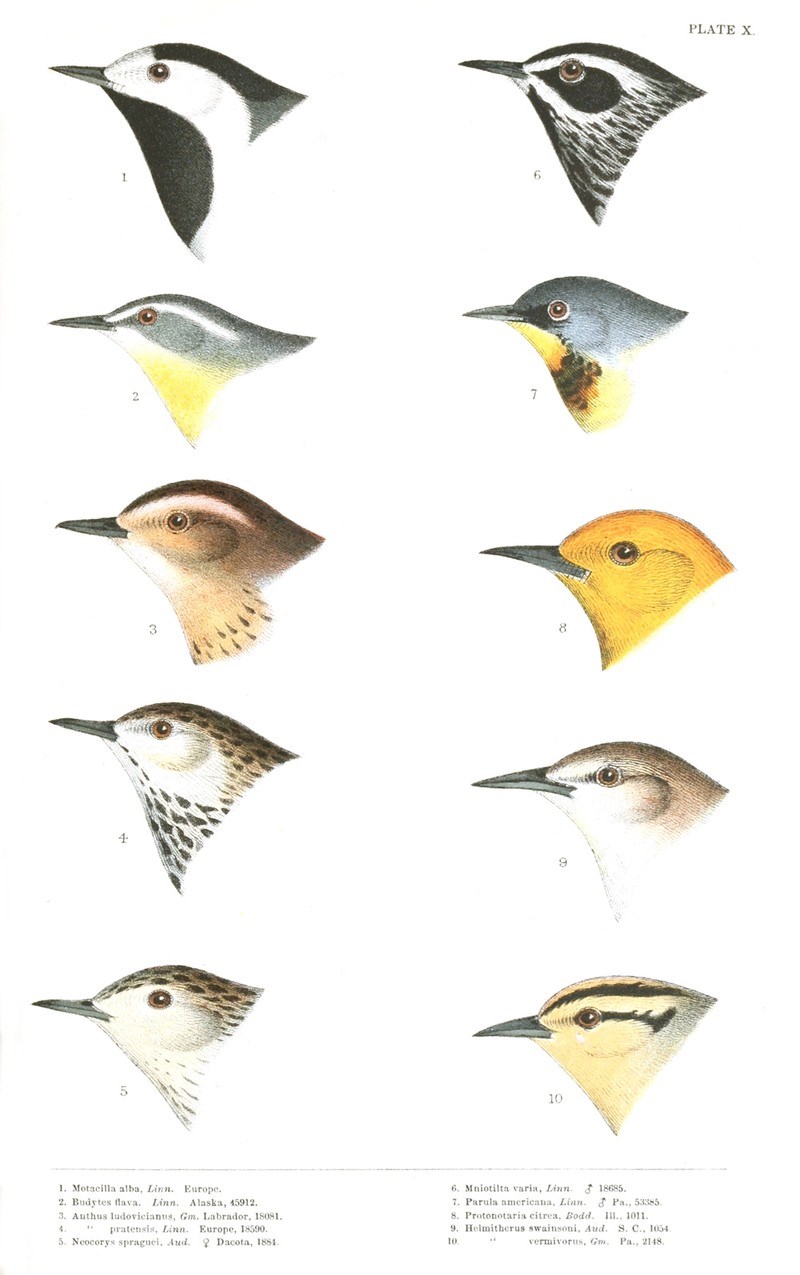
PLATE X.
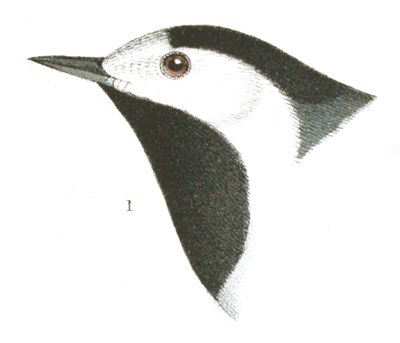
1. Motacilla alba, Linn. Europe.
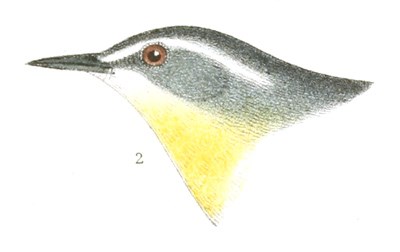
2. Budytes flava, Linn. Alaska, 45912.
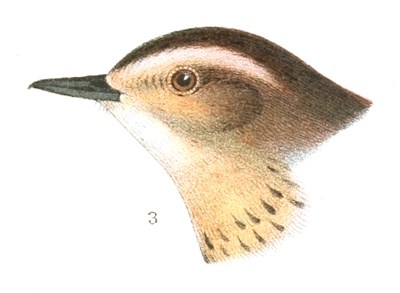
3. Anthus ludovicianus, Gm. Labrador, 18081.
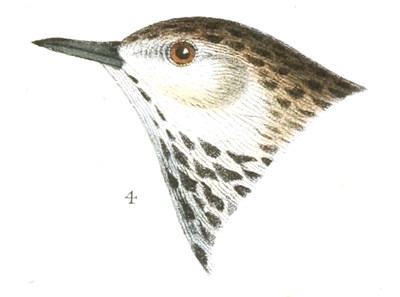
4. Anthus pratensis, Linn. Europe, 18590.
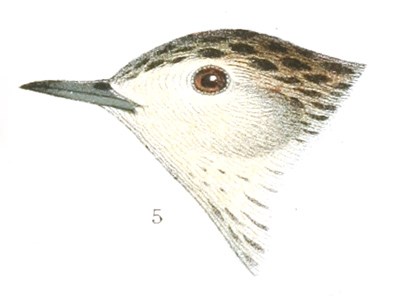
5. Neocorys spraguei, Aud. ♀ Dacota, 1884.
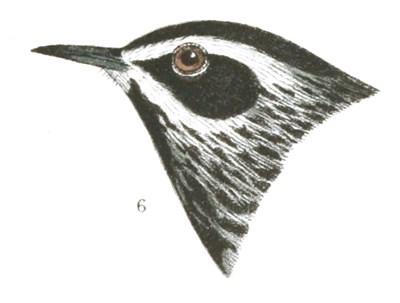
6. Mniotilta varia, Linn. ♂ Pa., 18685.

7. Parula americana, Linn. ♂ Pa., 53385.
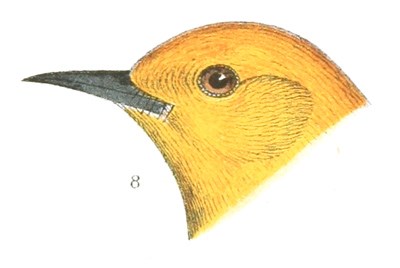
8. Protonotaria citrea, Bodd. Ill., 1011.




